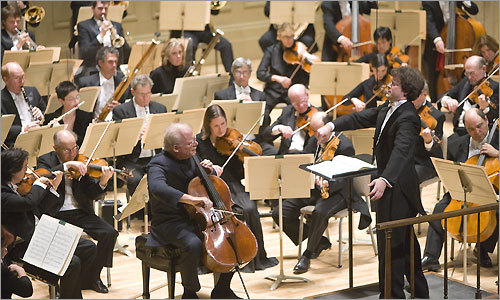|
Symphony
FROM THE NEW WORLD TO THE OLD WORLD
by Peter Lert
Saturday, June 14, 2025
Chamber
MC2 DUO RECITAL CLOSES 222'S SEASON
by Terry McNeill
Saturday, June 14, 2025
Choral and Vocal
CANTIAMO SONOMA'S LUSCIOUS A CAPELLA SINGING IN SEASON ENDING CONCERT
by Pamela Hicks Gailey
Sunday, June 8, 2025
Symphony
SRS SEASON ENDS WITH RESOUNDING TA-TA-TA-BANG
by Terry McNeill
Sunday, June 1, 2025
Symphony
YOUTHFUL VIRTUOSITY ON DISPLAY AT USO'S MAY CONCERTS
by Peter Lert
Saturday, May 17, 2025
Symphony
MYSTICAL PLANETS AND LIVELY GERSHWIN ORTIZ AT FINAL SRS CONCERT
by Peter Lert
Sunday, May 4, 2025
Symphony
VSO'S CONCERT MUSIC OF TIME, MUSIC OF PLACE
by Peter Lert
Sunday, April 27, 2025
VOCAL ELEGANCE AND FIRE AT THE 222'S RECITAL APRIL 26
by Pamela Hicks Gailey
Saturday, April 26, 2025
CANTIAMO SONOMA SINGS AN INSPIRED GOOD FRIDAY MOZART REQUIEM CONCERT
by Pamela Hicks Gailey
Friday, April 18, 2025
DRAMATIC SHOSTAKOVICH SYMPHONY CLOSES PHILHARMONIC'S 25TH SEASON
by Terry McNeill
Sunday, April 13, 2025
|
 |
 Cellist Lynn Harrell Playing the Dvorak Concerto |
MELODIOUS AND CONVINCING DVORAK BY HARRELL
by Terry McNeill
Friday, May 29, 2009
It’s not often that listeners have a chance to hear what arguably is the best work in a single classical genre, especially a concerto. On May 29, the Napa Valley Symphony offered just such an opportunity in Yountville’s Lincoln Theater when they performed the magnificent Dvorak Cello Concerto with veteran soloist Lynn Harrell.
Cello aficionados looking for a performance similar to Yo Yo Ma’s lyrical flights or Rostropovich’s magisterial intensity would have been disappointed, as Harrell provided an elegantly paced and ultimately low-key reading under the baton of Asher Raboy. Before a nearly full hall in the final concert of the Symphony’s 76th season, Harrell gave the luminous second theme of the opening Allegro movement rich color and nuance, never forcing the lush romanticism and always expanding on the phrases from the Orchestra. His duos with clarinetist Diane Maltester and the entire French horn section were captivating.
The poetic Adagio movement, both pastoral and troubled in character, found the soloist in a ruminating mood, never in a hurry to get anywhere. The three trills high up on the cello’s strings at the movement’s conclusion were played quietly and effortlessly, carrying to the back of the theater. The hall’s silence was palpable, though intruding applause broke the spell prior to the beginning of the final movement.
The Allegro moderato finale was full of restrained virtuosity, the opening march theme turning into a dance, the modulations frequent and telling. Concertmaster Yasushi Ogura traded graceful phrases with Harrell, their eyes seeming to reveal the joy of performing such opulent music, premiered in 1896 and a staple since for every concert cellist. The Orchestra responded to Raboy’s ebullient control, and joined in a rousing ovation for Harrell, along the mostly standing audience. In sum, Harrell offered a balanced, melodious and convincing performance of a passionate score.
The concert opened with Mendelssohn’s Overture to a Midsummer Night’s Dream, the initial sound harmed by a loud Friday night audience and lack of volume from the violins. Here, and in the following Jeu de Cartes of Stravinsky, the powerful brass section tended to swamp the high strings.
Written in 1936 for a ballet, the Stravinsky score seems to have infinite sections, and for me works better when the original dancers portray the convoluted but brilliantly scored music, often polytonal and alternatively sardonic and whimsical. The horns, sure-footed everywhere else, bobbled some notes but in no way diminished the florid decoration of sound. Principal flutist Rebecca Pollock-Ayers had a fetching solo in the first movement’s dance variation, and the winds all around were exemplary.
The syncopated rhythms Stravinsky first developed in his pre-classical period ballets (Firebird, Petrushka, the Rite of Spring) were still in evidence, as in the pulsing repeated notes from Scott Stubbs’ tuba. No composer of that era was able to combine such rhythmic power with such taunting orchestral timbre as did Stravinsky. Maestro Raboy’s pithy introductory remarks about the music’s origins were matched by his attention to the tricky details of keeping everything in balance. A lot of balls were in the air, and in the cards, in this agitated 20-minute performance.
Though facing financial hurdles as with other community orchestras, the Napa Valley Symphony is performing on a high level, playing challenging music with élan and professional finish.
|
